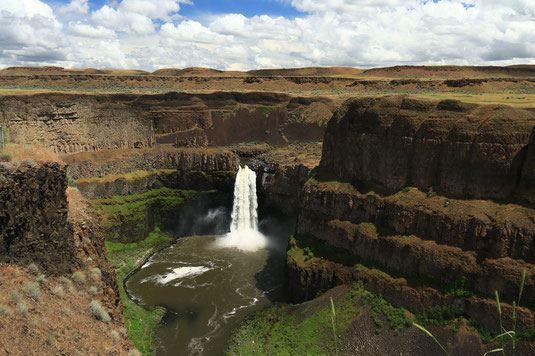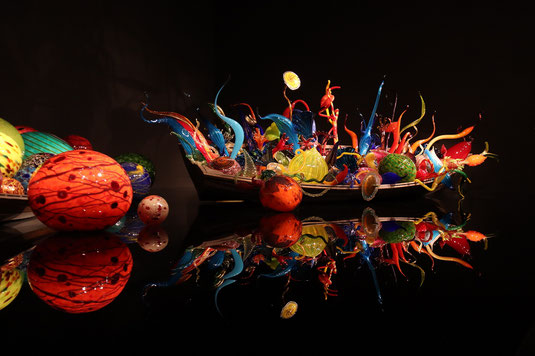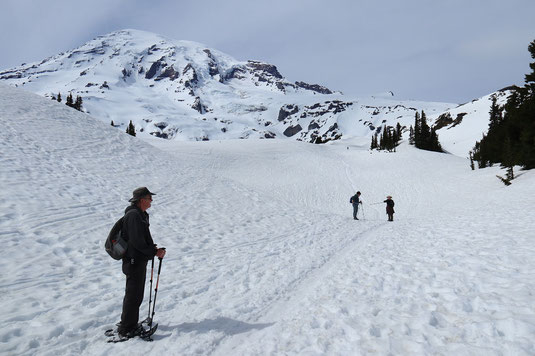Glass Gardens, Snow Avalanches and the Mount St. Helens Eruption -
Roadtrip USA Northwest I.
July 3, 2022

"Ten hours!?!”, I groan as I read the estimated driving time being displayed on our car’s sat nav.
"Well, we want to get to the Pacific sometime," replies my boyfriend, as he sits behind the wheel wearing his sunglasses and looking like Joe Cool, ready to cruise 17 hours non-stop to Mexico City.
We're on a three-week road trip through Washington, Oregon, California, and Idaho. I sometimes forget how big the U.S. is. Still.
After we drive through Yellowstone, I try to get some sleep until my boyfriend wakes me up. But only to excitedly show me a shabby mountain that used to be part of a mine. Great.
After another 1,600 years, we reach the Idaho border. "Hooray, we'll be at the campground in twenty minutes!", I exclaim exultantly, rubbing my butt which is now as flat as a waffle.
"You do realize we just crossed into a new time zone, right?" my boyfriend asks cautiously. "Pacific Time is an hour behind Mountain Time."
So that officially makes it one more hour of driving. I'm freaking out.
When we finally pitch our tent at sunset, the trip really begins. On the first part of our camping adventure through the northwestern U.S., I'll take you to a spectacular waterfall with a marmot, to one of the most surreal and colorful museums in the world, on a snowshoe hike with an avalanche, and to the place where Mount Saint Helens exploded in 1980.
Palouse Falls - created by ice age floods

Our first destination is Palouse Falls in Washington State. Because I don't like to Google my destinations to death in advance only to be disappointed by the reality later, I have no expectations. A waterfall on a hill. That's about all I know.
When we arrive, we find a green-brown canyon cutting through the land right before our eyes, as it winds tightly across an otherwise flat landscape of cornfields. In several distinct levels, brown basalt columns plunge to the 375-foot-deep gorge bottom. On our right, there are people, small as ants, standing on a viewing platform, and to our left, the Palouse Waterfall thunders 100 feet down into a semicircle of rock carved by the force of the falling water.
I look back and forth like an owl, but it's impossible to see the entirety of this huge, beautiful landscape in a single glance. Waterfall on a hill, my ass!
On a nearby ledge sits a marmot, preening itself, unimpressed. Even though it lives in a place that would make any landscape painter's brush fly out of his hands with enthusiasm.
The entire canyon was formed about 13,000 years ago. Almost as long as our driving time yesterday. By a flood of water, ice, and rocks in gigantomanic proportions. During the last Ice Age, ice sheets created a dam holding back more water than is currently held in two of the American Great Lakes (Erie and Ontario). When the ice broke, a huge volume of water and ice thundered towards the Pacific at a rate ten times greater than the flow rate of all the rivers in the whole world combined. Zounds! A canyon was suddenly carved into the earth!
Seattle: Platforms and plants made of glass

From this natural wonder, we now set off for the traffic chaos called Seattle. The windshield wiper rattles in third gear trying desperately to clear the deluge pouring from the sky as trucks sway back and forth in their lane in the spray. After two and a half months enjoying the silence of Iceland and Wyoming, I realize once again how little I want to see big cities.
The next day, on foot, things look different. We walk to the Space Needle, which was built in only 407 days for Expo 1962. At the top, a person can lean against a glass wall sloping outward and facing the skyline or stand on a rotating glass floor. Skeptically, I touch the tilted panels. What if the shit just breaks off while I'm leaning against it? Slamming down 184 feet onto Seattle wouldn't exactly be my highlight of the day right now. After several attempts, I finally find the courage to press my back against the slanted windows. I feel queasy.
Then I try the rotating glass floor. Maybe you can hold on to a wall pillar when the flying carpet cracks beneath you.

Speaking of glass. There's a combination ticket for the Space Needle and the Chihuly Garden and Glass Museum. The museum will showcase small, beautiful glass objets d’art behind glass panels, I am thinking.
As we enter the first darkened room, however, we have a Palouse Falls moment. Instead of small display cases, a huge, bright blue column of tangled glass arms stretches from the reflective platform on the floor almost to the infinite ceiling. Glass jellyfish, shells and starfish hide in the tentacles.
"Whoa, crazy shit!", I exclaim aloud.
In the next room we find a Persian Ceiling. A transparent ceiling filled with colorful collections of glass art objects that are lit unobtrusively from above; the artwork seems to glow from within and fills the room with shadowless rainbow colors. I'm freaking out. Alice in Chihulyland!
From there we head to a magical garden, boats full of surreal glass shapes, and then to monstrous chandeliers that would have filled my entire living room at home.
Outside, a greenhouse overflows with glass flowers and a real garden sprouts glass plants intermingled with natural flowers. Folks, if you only come to Seattle once in your life—try to go to this museum! It's mind-fucking-blowing.
Snowshoeing with an Avalanche on Mount Rainier

A huge mountain towers on the horizon of Seattle. More specifically, a volcano that would wipe out large parts of the city if it erupted. Mount Rainier.
Although it is June, snow is still falling like crazy when we get there. Half of Mount Rainier National Park and almost all hiking trails are closed because of it. Great Ghost of Muir!
Luckily, my boyfriend has an idea, "If we can't hike like we normally do, let’s rent some snowshoes!"
I'm on board immediately. I've never done a snowshoe hike before, and I want to do a whole lot of things in my life that I've never done before.
In the valley, we procure the “hiking shoes” that look like a cross between roller skates for elementary school kids and broken skis. With these we march upward on the mountain. Volcano. Whatever. The main hope is that the thing doesn't erupt while we are hiking up the side.
I feel like I have moon boots on my feet. Although with more gravity, not less. Snowshoes make it so you don't sink down in the snow so much, plus you have extra grip. But apart from that, it doesn't make walking on snow insanely easier. It is still an exhausting effort.
Eventually we reach our destination for the day: Glacier Point. The view from here is incredible: from a rough scree valley below us to the summit of Mount Rainier above.

On the way back, I suddenly hear a deep rumble behind us. I turn around and see a wall of snow breaking off near the summit. For a moment, I forget to breathe. An avalanche! I look around and then down at my snowshoes. Running away on snowshoes is pointless. And where to go anyway?
The avalanche begins to thunder down and my heart races up. I'm suddenly feeling so hot I'd like to pour snow down
my neck.
"What are we going to do now?!" I shout, trying to be heard over the distant roar.
My boyfriend points to a small hill nearby and shrugs his shoulders. "But between us and the avalanche there is still the scree valley, the snow can’t get past it," he tries to reassure me.
I just continue to stare at the huge, white, descending wall. It gets slower and slower and finally stops. I am relieved. But my hands continue to tremble. For quite a while.
Mount Saint Helens: The mountain that simply exploded

We again experience the power of nature when we get to Mount Saint Helens. The famous volcano that exploded in Washington State in 1980. A place I've always wanted to see in person.
Now we are here. At Johnston Ridge. The spot where scientist David Johnston stood with his radio on the morning of May 18, 1980, yelling, "Vancouver, Vancouver, this is it!"
He was in a safe area, six miles from the volcano when it erupted. But Mt. St. Helens surprisingly erupted sideways, not up, hurtling its entire peak into the air toward Dr. Johnston. Seconds later, the blast wave reached him, and he was killed.
The disrupted landscape of deep furrows and canyons, devoid of trees, riddled with mud valleys and boulders that once belonged to the mountain's peak, is truly haunting. The crater gapes open, directly in front of us. Monumental. I have goosebumps imagining what happened at this location in 1980.
In the extremely informative museum right at the Ridge, there are eyewitness accounts. Of a family that camped in a small forest near the volcano and that survived only because a protective hill saved them from the pyroclastic cloud. Of a man who pulled his girlfriend by the hair out of the raging river of pure mud after she disappeared completely. Or of a construction worker around whom the day suddenly became black as night. When he could see again, he discovered the charred corpses of all his colleagues around him.
The US Northwest is wild, filled with volcanoes, full of snow, and full of natural wonders. The first part of our road trip impressively demonstrated to us just how tiny we humans are—not only when standing at the edge of a canyon, but also generally as we stand on our planet, enveloped by an unpredictable nature.





